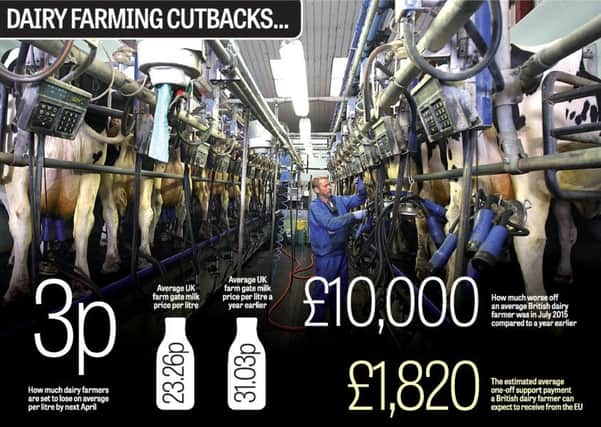Dairy cash crisis forecast to last into the new year for worst paid


Dairy farmers are estimated to lose nearly three pence per litre (ppl) over the course of the financial year ending next April when total farm profits have been considered, accountants at Old Mill said, putting real financial strain on the majority of farmers who are suffering from milk prices way below the cost of production.
The average farm gate milk price is 23.26ppl, latest figures show, down from 31.03ppl a year earlier because of a global oversupply of milk.
Advertisement
Hide AdAdvertisement
Hide AdAndrew Vickery, the accountancy’s head of rural services, said: “Dairy farmers are facing challenging times with little indication that this will be changing in the near future.
“Producers with March 2015 year-ends have shown a reasonably healthy profit in most cases, due to a stronger milk price for the first half of that year. But for 2015/16 it is not such a positive picture.
“Cash flow is becoming an issue for many producers so it’s important to look forward and plan ahead.”
An accord struck last month by European ministers aimed to offer some short-term cash relief to dairy farmers, but the outcome of a £15.5 million UK support package amounts to an average payment per dairy farmer of £1,820. The sum will do little to ease the situation, said Rob Harrison, dairy board chairman of the National Farmers’ Union.
Advertisement
Hide AdAdvertisement
Hide Ad“British dairy farmers, on average, were £10,000 worse of in July this year compared to the same time 12 months ago,” Mr Harrison said. “How much difference will the average payment of £1,800 make?”
A worryingly trend is a widening profit gap which is opening up between the lowest and highest paid dairy farmers, said Gerard Finnan, a partner at the Farm Consultancy Group.
Mr Finnan said: “In 2014/15 the bottom quartile received 2.13ppl less for their milk and made a loss of 1.55p/litre against a profit of 10.1p/litre for the top quartile. The bottom 25 per cent of farmers’ costs of production were also 8.05p/litre higher, so unless they can dramatically reduce expenditure the outlook for 2015/16 is pretty concerning.”
Yorkshire-based dairy farmers are being invited to apply to supply milk to a new co-operative, which founder and Northumberland dairy farmer Peter Crawford, said will offer farmers 3-4ppl above their current prices.
Advertisement
Hide AdAdvertisement
Hide AdHis new ‘Free Range 180’ brand will see milk supplied by co-operative members processed through County Durham-based Lanchester Dairies. The concept is based upon members grazing their cows outside on grass for a period of six months.
Gary Halliday, general manager of Lanchester Dairies, which supplies dairy products across the North of England and into Scotland, said: “Free Range 180 is effectively ‘ring-fenced’ through the Lanchester network of dedicated farmer suppliers as well as our extensive retail network.”
Standards drive to boost exports
Leeds-based Arla Foods is looking at how it can boost the export marketability of its British milk by strengthening the production standards of its farmer suppliers.
The co-operative has been working with the Red Tractor farm assurance scheme to develop its own ‘Arlagården’ assurance programme in the UK, after launching it elsewhere in Europe.
Advertisement
Hide AdAdvertisement
Hide AdThe new programme means dairy farmers who supply milk to Arla will have to meet an additional 16 milk quality, food safety and animal welfare standards, which include ensuring they limit the use of antibiotics to treat their cattle.
Ash Amirahmadi, head of milk and member services at Arla Foods UK, said: “Arlagården is an independently audited standard that proves our farmers’ commitment to producing quality milk, caring for their cows and using antibiotics and medicines responsibly.”